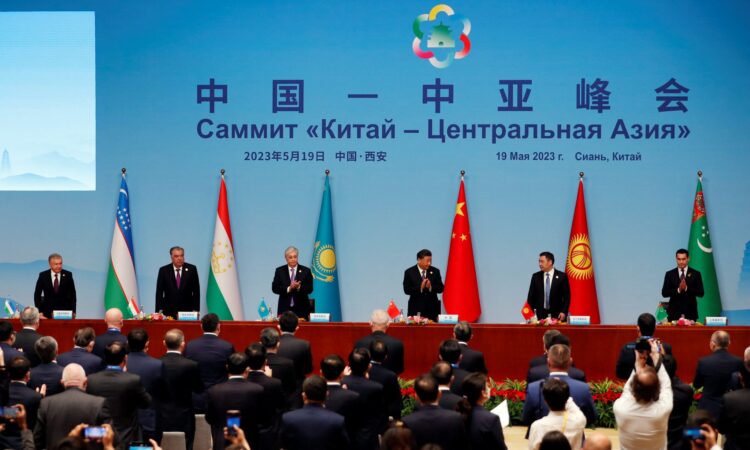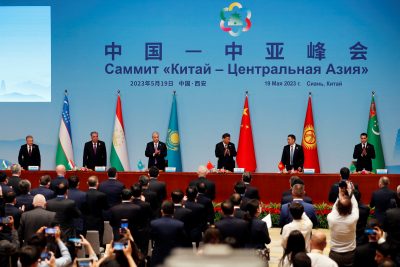
Author: Richard Pomfret, University of Adelaide
In 2023, the Central Asian leaders showed increased willingness to institutionalise cooperation through annual summits and unified approaches to third countries. Despite foreign policy challenges associated with the Russia–Ukraine war, water disputes with Afghanistan and clashes on the Kyrgyz–Tajik border, the focus of these meetings remained economic.

Since 2017, the five Central Asian leaders have met in Central Asian Summits in Almaty (Kazakhstan, 2018), Tashkent (Uzbekistan, 2019), Awaza, Turkmenistan (2021), and Cholpon-Ata, Kyrgyz Republic (2022). The September 2023 summit in Dushanbe, Tajikistan, was also attended by Azerbaijan President Aliyev. The post-summit briefing emphasised that ‘the primary task is to develop cooperation in the trade and economic field and create favourable conditions for trade and investment’.
Since Russia’s 2022 invasion of Ukraine, the trade and infrastructure focus has shifted to East–West connectivity, with the Middle Corridor — from China to Europe via Central Asia and Azerbaijan — gaining attention as an alternative to the main Europe–China rail connection through Russia. A June 2023 study by the European Bank for Reconstruction and Development foreshadows infrastructure investment of €18.5 billion (US$19.97 billion) by the European Union (EU) in Middle Corridor routes. Central Asian producers increasingly use the Middle Corridor to export goods like fertilisers, lentils and apparel to Europe, Turkiye, and the Middle East.
The five leaders have increased collaboration in external relations. The C5+1 format for meetings with heads of government originated in the December 2019 meeting in Delhi between the five Central Asian presidents and Prime Minister Narendra Modi. Live meetings were difficult in 2020–21 due to COVID-related travel restrictions. The November 2022 EU–Central Asia Connectivity Conference in Samarkand was attended by the high representative of the EU for foreign affairs and foreign ministers of the five Central Asian countries.
The high-level meeting in Cholpon-Ata with President of the European Council Charles Michel in June 2023 is to be followed by an EU–Central Asia Summit in Uzbekistan in 2024. A May 2023 in-person summit with Chinese President Xi Jinping in Xi’an followed a virtual China–Central Asia Summit in January 2022. A C5+1 Presidential Summit with US President Joe Biden was held in New York in September 2023. The C5 format asserted a shared self-image shaped by history, geography and culture — a shared vision that did not include Russia.
Following Russia’s invasion of Ukraine, Central Asia has economically benefited from re-routed trade and disaffected Russians setting up bank accounts and small businesses in Tashkent, Almaty and other Central Asian cities. But the Central Asian governments have distanced themselves from Russia’s war, abstaining to vote for or against the 2022 UN motion condemning Russia’s invasion. In 2023, they carefully avoided declarations of support for Russia while making statements in support of Ukraine’s territorial integrity.
In the Soviet era, the Central Asian republics were economically tied to the Russian republic by supply chains that ran along north–south roads, railways and pipelines. Since the dissolution of the Soviet Union in 1991, the independent countries of Central Asia have reduced dependence on Russia. The Central Asian countries have built new infrastructure, found new suppliers, markets and pursued ‘multi-vector diplomacy’, culminating in meetings and summits with the world’s greatest powers. Though Russia remains an important partner, it is no longer the top importer, exporter or investor in Central Asia.
The Russia–Ukraine war reinforced this reorientation as countries emphasised their infrastructure plans to boost east–west links. Efforts include upgrading Caspian Sea ports, focusing on western Kazakhstan’s road and rail connections to Uzbekistan and potential links to Kashgar in western China and to Afghanistan.
Since the resource boom ended, the process of diversifying Central Asian economies and reducing economic dependence on Russia has been gradual. The year 2023 has shown how far both have progressed. Though 2024 may bring external shocks stemming from the uncertainties surrounding neighbouring countries — Ukraine, Afghanistan and Iran — and domestic problems like autocratic leadership, corruption, susceptibility to natural disasters and border disputes in the Ferghana Valley remain. Ongoing cooperation, increased distancing from Russia and economic progress under a new generation of leaders is expected in 2024.
The longer-term prospect is for Central Asia to return to its historic role as a Eurasian crossroads after 150 years of north–south orientation under Russian hegemony. While the north–south links remain, China, Turkiye and the EU actively collaborated to promote east–west links in 2023. Subject to political developments, the door is open to revitalise southern links to Afghanistan, Iran and Pakistan.
Richard Pomfret is Adjunct Professor of International Economics at the Johns Hopkins University SAIS Europe in Bologna and Professor of Economics Emeritus at the University of Adelaide.
This article is part of an EAF special feature series on 2023 in review and the year ahead.






